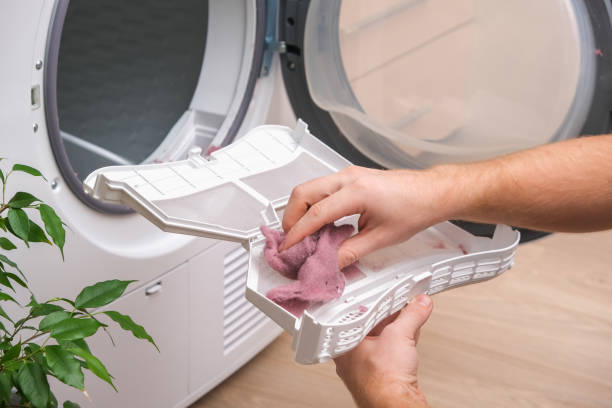
What Happens If You Neglect cleaning Your Dryer Lint Trap in New York
If you’ve ever pulled out a fluffy mat of lint from your dryer’s trap and thought, “Eh, I’ll skip it next time,” you’re not alone. It seems harmless, right. But having lived in New York for years, I’ve seen how skipping this tiny chore can cause big, expensive, and even dangerous problems. Cleaning dryer lint trap is a quick, easy habit that pays off with safer living, smoother laundry days, and fewer repair calls. Don’t underestimate this small step—it truly makes a huge difference. In a city where apartments are stacked tight and laundry rooms are often tiny, a clogged lint trap isn’t just an inconvenience—it can be a hazard.
The Domino Effect: What Really Happens When You Skip Cleaning?
| Neglected Lint Trap Issue | What Can Happen | How It Affects You |
|---|---|---|
| Airflow Blocked | Dryer works harder, clothes take longer to dry | Higher energy bills, wasted time |
| Lint Build-Up | Risk of overheating and fire increases | Danger to your home and family |
| Moisture Trapped | Clothes come out damp, musty odors develop | Extra laundry loads, smelly laundry room |
| Machine Wear & Tear | Dryer components break faster | Costly repairs or early replacement needed |
Imagine your dryer as a runner. If you stuff a towel over their mouth, they’ll have a tough time breathing—and soon collapse. The same thing happens to your dryer when lint blocks up its “airways.” Everything becomes harder, slower, and less safe.
Fire Risks: Not Just a Scare Story
New Yorkers know space is tight and buildings are old. Clogged lint traps are one of the most common causes of residential fires—not just in houses, but in high-rise buildings too. The lint itself is super flammable, and when heat can’t escape, all it takes is a spark or a little extra heat to set things off.
Firefighters in the city respond to dozens of dryer-related fires every year. It’s not just the loss of laundry—an entire apartment or building can be threatened. If you’re renting, this could mean losing your security deposit, or worse, facing liability for damages.
“A little lint left behind today can turn into a big headache tomorrow.”
How Much Could Neglect Really Cost You?
Let’s talk dollars and cents, because neglecting that lint trap isn’t just risky—it can hit your wallet hard. Here’s a quick breakdown showing potential costs if you let things slide:
| Problem | What You Might Pay (NYC Prices) |
|---|---|
| Increased Electric Bill (per year) | $120 – $250 |
| Dryer Repair | $150 – $400 |
| Dryer Replacement | $600 – $1,500 |
| Fire Damage (minor) | $2,000 – $8,000 |
| Fire Damage (major) | $10,000 – $50,000+ |
Compare that to the few seconds it takes to swipe out the lint after each load!
Simple Habits, Big Difference
You don’t need fancy tools or special skills to stay safe and save money. Just make it a habit to clear the lint trap every time you use the dryer. If you do laundry in a shared space, double-check the trap before you start—you never know if the last person remembered. Once a year, consider a deeper clean of the vent (or ask your landlord).
A little consistency goes a long way in keeping your home safe, your bills low, and your dryer humming along for years.
FAQs About Dryer Lint Traps in New York
How often should I clean my dryer lint trap?
After every single use! It takes just a few seconds and keeps things running smoothly.
Can a full lint trap really cause a fire?
Absolutely. Lint is highly flammable, and a blocked trap lets heat build up dangerously.
What if I use a laundromat?
Always check the trap before using the dryer, even if it’s not “your” machine. Safety first!
Does a clogged lint trap make my clothes smell?
Yes! Damp lint can lead to musty odors, and your clothes may come out less than fresh.
Final Thoughts: Don’t Let Lint Sneak Up On You
It’s easy to overlook something as small as a bit of lint, but in New York—where space is limited, schedules are packed, and every second counts—this tiny task can make a world of difference. A clean lint trap doesn’t just keep your dryer running efficiently; it also plays a major role in keeping your home safe from fire hazards. Over time, even a thin layer of lint can restrict airflow, forcing your dryer to work harder, use more energy, and take longer to do its job. That means higher utility bills, more wear and tear on your appliance, and even the risk of a dangerous fire. In a city where convenience and safety go hand in hand, taking a moment to clean your lint trap after each use is one of the simplest and smartest habits you can build. So, the next time your dryer buzzes, take that extra second for a quick swipe. It might seem small, but it could save you time, money, and serious headaches down the road.
Read More: New York Dryer Vent Cleaning


